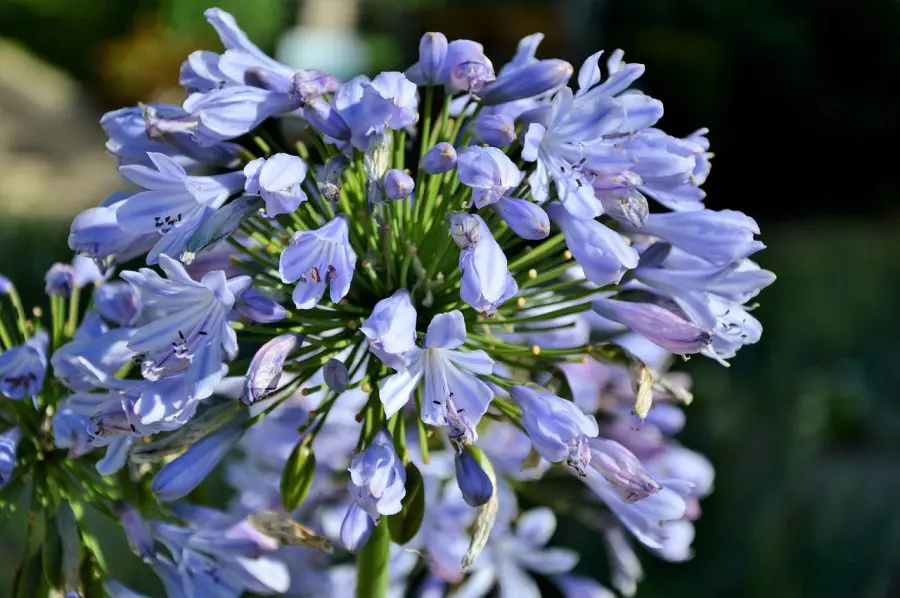This post contains affiliate links. If you buy something from one of our links we may earn a commission. Thanks

Discover the joy of Agapanthus Care in Pots! Uncover expert tips to grow and nurture these vibrant African Lilies in your own home, all year round.
Agapanthus care in pots involves placing the container in a sunny to partially shaded location and using well-draining soil. Water the plant regularly but let the soil dry out between waterings. During the growing season, apply a balanced fertilizer every 4-6 weeks for optimal blooming. Overwinter indoors if temperatures drop below freezing.
Welcome, green thumbs and budding gardeners alike! Have you ever considered bringing a touch of the exotic into your home or garden? Well, you’re in luck!
We’re delving into the mesmerizing world of Agapanthus Care in Pots.
These African beauties, commonly known as the Lily of the Nile, can transform your space with their vibrant blooms and lush, strap-like leaves.
Whether you’re a seasoned horticulturist or a gardening newbie, we’re here to guide you on this rewarding journey.
So, roll up your sleeves, grab your favorite pot, and let’s explore the secrets of nurturing these South African gems together!
Introduction Agapanthus Care In Pots
Hello, plant enthusiasts and flower aficionados! Today, we’re diving into the captivating realm of Agapanthus care in pots.
This splendid South African native, also known as the African Lily, is a show stopper with its vibrant blue or white flowers and luxuriant foliage.
But how do you foster this tropical treasure in a pot? We’ve got you covered with a comprehensive guide touching on everything from the initial planting stage, selecting the hardy or evergreen variety that fits your needs, to seasonal care tips including winter protection.
We’ll also delve into the best practices for dividing your Agapanthus, ensuring you enjoy bountiful blooms year after year.
So, let’s roll up our sleeves and dive into the world of potted Agapanthus care!
Understanding Agapanthus: The African Lily
 The Agapanthus is a flower that captivates hearts with its striking hues of blue and white!
The Agapanthus is a flower that captivates hearts with its striking hues of blue and white!
Commonly known as the African Lily or Lily of the Nile, this South African native is a testament to the continent’s rich biodiversity.
With its robust evergreen or deciduous types and clusters of star-shaped flowers atop sturdy stems, it truly is a sight to behold.
But it’s not just about the looks; the Agapanthus is a hardy plant that’s surprisingly versatile, capable of thriving both in garden beds and pots.
The Significance of Proper Care: Growing Agapanthus In Pots Successfully
Now, you might be wondering, with such hardiness and flexibility, does the Agapanthus require any special care?
While Agapanthus plants are generally easy-going, they do have certain needs to truly flourish.
It’s a bit like making a new friend and understanding their likes and dislikes goes a long way in forging a strong bond.
For Agapanthus, this means providing them with conditions akin to their native habitat.
This includes an ample amount of full sun, well-drained soil, and the right balance of water and nutrients.
This guide will walk you through all these aspects of Agapanthus care, so you can grow these stunning plants successfully, even in pots.
After all, who wouldn’t want a touch of African beauty right in their living room?
How to Grow Agapanthus in Pots
Alright, let’s get our hands dirty and dive right into the fun part, growing Agapanthus in pots!
Now you might be thinking, why pots?
Well, growing Agapanthus in pots allows for versatility and mobility, meaning you can move them around to catch the sun or even bring them indoors in colder seasons.
Plus, they make fantastic decorative additions to your patio, balcony, or indoor space.
But as with all things gardening, there’s a method to the madness.
So, join me as we embark on this delightful journey of potting and nurturing your Agapanthus, ensuring these South African beauties feel right at home, no matter where you place them.
We’ll cover everything from choosing the right pot to the best time for planting, and before you know it, you’ll have a row of Agapanthus blooming brilliantly in their new homes. Let’s get started!
Embracing the Sun: The Need for Full Sun and Well-Drained Soil
Basking in the sun isn’t just for beachgoers. Your Agapanthus plants crave that sunny spot too.
Remember, these plants are natives of sunny South Africa, so they’re all about soaking up those rays.
Choose a location that gets full sun exposure for the best results, and if you’re growing them indoors, a bright window would be a perfect spot.
But the sun isn’t everything and the soil has an equally important role to play.
Agapanthus needs well-drained soil to avoid root rot and other waterlogged conditions.
A good rule of thumb is to use a potting mix that allows water to flow easily.
Remember, the key to a happy Agapanthus is a balance of sun and well-drained soil.
Timely Planting: The Advantage of Early Spring
When it comes to planting Agapanthus, timing is everything.
Early spring, just as the new growth is starting, is the best time to get your Agapanthus in the pot.
Why spring? Well, this gives your plants a full growing season to establish their root systems and soak up all those nutrients before the colder winter months.
Plus, it’s during these warmer months that Agapanthus rewards you with its stunning blue or white flowers.
The Planting Process: Depth, Distance, and Details
Now that we’ve got the timing down, let’s move on to the planting process itself.
Plant your Agapanthus just deep enough to cover the roots, usually about 3 to 4 inches below the surface of the soil.
This depth ensures that the plant is well-anchored and its roots have plenty of room to expand, while also being close enough to the surface to readily access water and nutrients.
Ensure the crown of the plant, where the stems emerge, is level with or slightly above the soil surface to prevent waterlogging and promote healthy growth.
If you’re planting in a 12” pot, a single plant will do just fine, but feel free to add more in larger pots.
Keep in mind that Agapanthus likes to be crowded in pots, as restricted root growth can induce heavier flowering.
But remember, too much of a good thing can be harmful, so avoid overcrowding.
Just imagine your pot as a mini dance floor – you want it crowded enough to be fun, but not so packed that no one can move!
Selection of the Best Agapanthus for Pots
Welcome to the vibrant world of Agapanthus, where deciding on the perfect plant for your pot might be the toughest choice you’ll make all day!
With a multitude of varieties to choose from, each with its own charm and characteristics, it can feel like a daunting task.
But don’t worry, we’ve got your back. In this section, we’ll guide you through the maze of options, highlighting the top contenders for pot culture.
From the hardy types braving the cold to the evergreen ones offering year-round greenery, we’ll help you find the Agapanthus that’s just right for you and your pot.
Let’s dive in and find your perfect pot companion!
Exploring the Diversity of Agapanthus Species
Whether you’re a fan of evergreen plants that stay lush throughout the year or you’re drawn to the seasonal cycle of deciduous types, there’s an Agapanthus species for you.
Evergreen Agapanthus species, like the Africanus and Orientalis, keep their strap-like leaves all year round.
They’re a great option if you’re looking for a plant that provides constant visual interest.
On the other hand, the deciduous types like Agapanthus campanulatus shed their leaves in colder months, but make up for it with a stunning display of flowers when the growing season arrives.
They truly bring the cycle of seasons into your home or garden!
Hardy Agapanthus: The Cold-Weather Champion
If you live in a region that’s a bit on the chilly side, don’t worry – you can still enjoy the beauty of Agapanthus!
Some varieties, often referred to as hardy Agapanthus, are built to withstand colder areas.
They might take a little extra care over winter, perhaps some additional protection like mulching or moving the pots to a sheltered spot, but they will reward you with a stunning flower show when summer arrives.
Planting Bare Root Agapanthus in Pots: The Journey Begins
When it comes to planting bare root Agapanthus in pots, it’s all about giving your new plant a strong start.
Ensure you have a pot with good drainage holes to prevent waterlogged soil and root rot.
Plant the bare roots just deep enough to cover them with soil, ensuring the crown is at soil level.
The beginning of spring is the best time for this, allowing the plant to establish its roots before the peak growing season.
The Best Agapanthus for Pots: Size and Color Matter
When choosing Agapanthus for pots, considering the size and flower color can make a significant difference.
Smaller varieties, like the dwarf Agapanthus, are perfect for pot culture.
They won’t outgrow their space too quickly, and they have a tendency to bloom more profusely when slightly root-bound.
As for color, it’s all about your personal preference. You can choose from the pure white flowers of Agapanthus ‘Queen Mum’ or the vibrant blue of Agapanthus ‘Northern Star’.
You could even mix it up with a variety of colors for a real pot-based spectacle!
Crafting the Perfect Potting Mix: Coco Coir and Perlite
The importance of a good potting mix cannot be overstated when it comes to successful Agapanthus care in pots.
An ideal potting mix should be able to hold moisture while also providing excellent drainage, and this is where coco coir and perlite come in.
Coco coir, made from the husks of coconuts, is a fantastic medium for potting plants. It’s natural, renewable, and it excels at retaining moisture.
This means that water is available to your Agapanthus plants for a longer time, reducing the frequency of watering.
But while moisture retention is vital, it’s equally important that your potting mix drains well to prevent waterlogging and root rot.
This is where perlite, a type of volcanic glass, comes in. Perlite is lightweight and has a porous surface, making it perfect for enhancing soil aeration and drainage.
Combining coco coir and perlite gives you a potting mix that’s not only great at retaining water but also well-draining.
This mixture provides the ideal conditions for your Agapanthus’ fleshy roots to thrive.
With this combo, you are well on your way to growing healthy and vibrant Agapanthus in pots!
Agapanthus Care Over the Seasons
Is it spring, summer, fall, or winter? No matter the season, your Agapanthus will need some TLC!
In this section, we’ll guide you on how to provide year-round care for your Agapanthus in pots.
From nurturing new growth in the spring, to ensuring they bloom spectacularly in the summer, to protecting them during the colder months, we’ve got you covered.
It’s all about understanding what these South African beauties need as the seasons change.
So, whether you’re dealing with evergreen or deciduous varieties, we’ll help you ensure your Agapanthus remains a vibrant showstopper all year long!
Wintering Your Agapanthus: Protection and Drainage
Chilly winter months can be a bit challenging for your Agapanthus, especially if you’re in a colder area.
But don’t worry, these resilient plants can weather the cold with a little help from you!
When it comes to winter care, your main focus should be protection and good drainage.
Move your Agapanthus pots to a sheltered spot, such as an unheated greenhouse or a frost-free place.
Remember, waterlogged soil during cold weather can lead to root rot, so ensure your pots have good drainage.
It’s a great idea to raise them off the ground using pot feet or bricks.
The Art of Dividing Agapanthus in Pots
As your Agapanthus grows, it may start to feel a bit crowded in its pot.
This is the best time to divide it and encourage more vigorous growth.
The rule of thumb is to divide your Agapanthus after flowering, typically in early spring or early fall.
Using a sharp knife or a garden fork, carefully cut the clump into sections, each with roots attached.
Plant these divisions into smaller pots filled with a well-drained potting mix.
Remember, patience is key! It may take until the following year for these new plants to flower.
Sizzling Summer Care for Agapanthus
Agapanthus loves the summer months – after all, it’s native to sunny South Africa!
During this time, your Agapanthus will need plenty of water and feed to support its blooming glory.
Place your pots in a sunny spot, but be mindful of extremely hot weather which may require more frequent watering.
Regular feeding with a balanced fertilizer or tomato feed during the growing season will also promote lush growth and prolific flowering.
And don’t forget to deadhead spent flowers to encourage more blooms!
Early Fall Care: Prepping for the Next Season
As summer fades into fall, it’s time to prep your Agapanthus for the colder months ahead.
Start by deadheading the spent flowers, leaving the flower stems to die back naturally.
This process aids in seed production and gives your plant a bit of a rest period.
Also, pay attention to the root development. If the roots are pushing the plant out of the pot, it might be time to consider a larger pot or division of the clump.
Remember, a well-cared-for Agapanthus is a happy Agapanthus, ready to grace you with stunning blooms come next season!
Additional Tips for Agapanthus Care
Are you ready to take your Agapanthus care to the next level? You’ve got the basics down, and now, it’s time for some pro tips!
In this section, we’ll delve into additional pointers that can make a big difference in your Agapanthus plants’ health and blooming prowess.
From exploring different soil types to optimizing your watering routine, we’ve got a host of useful nuggets to help you become the Agapanthus whisperer you’re meant to be.
Let’s dive right into these bonus tips for the optimum Agapanthus care in pots!
Choosing the Right Plant Pot for Agapanthus
Choosing the right plant pot is no small decision when it comes to Agapanthus care in pots.
Terra cotta pots are a popular choice among many gardeners due to their breathability, which helps to prevent waterlogging and root rot.
Furthermore, a pot with sufficient drainage holes is essential.
These allow excess water to escape, keeping your Agapanthus’ fleshy roots healthy and preventing the dreaded soggy soil situation.
Creating Ideal Growing Conditions with the Right Soil
The magic of Agapanthus lies not just above the soil, with their blue or white flowers, but also beneath, in the healthy roots and soil.
The type of soil you use plays a vital role in your Agapanthus’ health.
Aim for well-drained soil, possibly enriched with organic matter. This type of soil mimics the natural conditions of Agapanthus in South Africa and provides them with essential nutrients.
The Smaller Pot Advantage for Single Agapanthus Plant
When it comes to Agapanthus, they’re a bit of a paradox. They love room to grow but also enjoy a bit of a squeeze.
Planting a single Agapanthus in a smaller pot can encourage new growth and robust flower production.
It seems they love the cozy conditions and respond by blooming beautifully. A rule of thumb is to start small and size up as needed.
Knowing When and How to Transition to a Larger Pot or Garden Bed
Just as important as starting small is knowing when it’s time to give your Agapanthus more room.
Once your plant begins to look a little too snug in its pot or starts pushing against the sides, it’s a clear sign that it’s ready for a bigger home.
Similarly, if you want to introduce your potted Agapanthus to the freedom of a garden bed, we’ll guide you through that process.
It’s all about timing and careful movement to ensure your Agapanthus transitions smoothly without damaging the root systems.
Transitioning Your Agapanthus to a Garden Bed
If your Agapanthus has outgrown its pot or you just want to add some color to your garden beds, the transition from pot to garden can be a rewarding process.
Firstly, you should ensure the conditions in the garden mirror those of the pot.
A sunny spot with well-drained soil is ideal. Secondly, the best time for this transition is in early spring or early fall when the weather is mild.
• To start the process, prepare the garden bed with a generous amount of organic matter mixed into the soil for added nutrients.
• Then, carefully remove the Agapanthus from its pot, trying not to disturb the root system too much.
• Dig a hole in your garden bed that is twice as wide and as deep as the plant’s root ball.
• Place your Agapanthus in the hole, ensuring that the top of the root ball is level with the soil surface.
• Backfill the hole with the enriched soil, firming it gently around the base of the plant.
• Finally, water it thoroughly and keep the soil moist but not waterlogged until you see signs of new growth.
Remember, Agapanthus are resilient and will adjust to their new environment in time.
With the right care and attention, your transplanted Agapanthus will continue to flourish and bring joy to your garden with its vibrant flowers.
Propagating Agapanthus
Hey there, green thumbs! Ready to multiply the beauty of your Agapanthus?
In this section, we’re diving into the rewarding world of propagating Agapanthus.
Whether you’re a seasoned gardener or just starting out, don’t worry because we’ve got you covered.
We’ll walk you through the step-by-step process, from growing these African lilies from seeds to dividing mature plants.
Let’s turn that single Agapanthus into a stunning row of these gorgeous blooms!
Understanding Agapanthus Propagation
Agapanthus propagation – sounds like a mouthful, doesn’t it?
But don’t worry, it’s just a fancy way of saying, let’s make more of these beauties!
When we talk about propagation, we’re referring to the process of creating new plants from the one you already have.
With Agapanthus, there are two main methods: growing from seeds and division.
Division is splitting the root clump of a mature plant to make two or more new ones.
Growing from seeds is a slower process, but it’s so satisfying to see new life sprout from those tiny seeds.
Now, let’s dive deeper into how you can propagate your Agapanthus plants and fill your garden or your pots with these stunning blooms.
The Journey from Seed to Splendor
Starting Agapanthus from seeds is a journey, but watching those tiny seeds transform into a dazzling display of blooms makes it all worthwhile.
So, when’s the best time to start this journey? Right after the last frost of the winter as this gives your seedlings a full growing season to establish themselves.
Now, let’s talk about preparing the seeds. With Agapanthus, you don’t need to pre-treat the seeds or soak them overnight.
Just sow them directly into a seed tray filled with coco coir and perlite or good-quality seed compost. Keep them moist, but not waterlogged.
Once your seedlings are large enough to handle, usually when they have a couple of sets of true leaves, transplant them into individual pots.
Remember, these baby plants will need a little extra TLC, so keep them in a sheltered spot with partial shade until they’re strong enough to handle full sun.
Doubling the Beauty: Agapanthus Division
Dividing Agapanthus is like getting two plants for the price of one.
It’s best to divide Agapanthus in the early spring or late summer, right after they finish flowering.
This gives the new plants enough time to settle into their new homes before the growing season kicks in.
Start by carefully removing the parent plant from its pot. Using a sharp knife or garden fork, divide the root clump into two or more sections, each with a healthy piece of root and a few leaves.
Then, plant each new section into a pot filled with well-draining soil.
Voila! You’ve just created new Agapanthus plants. Don’t forget to give them a good watering and place them in a sunny spot.
With a little bit of patience and care, you’ll soon see them flourishing.
Dealing with Pests and Diseases
Even the hardy Agapanthus isn’t completely immune to the odd pest or disease.
With a little knowledge and a keen eye, you can keep your potted African Lilies in tip-top shape.
In this section, we’ll discuss some common issues you may encounter with your Agapanthus care in pots.
Let’s start the journey, and arm you with effective solutions to keep your plants healthy, happy, and blooming.
Identifying Pests and Diseases
Aphids: These small, green or black insects are often found on new growth or underneath leaves.
They suck sap from the plant, leading to yellowing or distorted growth.
If you notice a sticky residue on your plant or nearby furniture, it’s likely you have an aphid problem.
Snails and Slugs: These pests love the tender leaves of the Agapanthus.
Telltale signs include visible trails and irregular holes in the foliage.
Fungal Diseases: Agapanthus can occasionally be affected by fungal diseases, such as leaf spot or powdery mildew.
Look out for discolored, spotted, or powdery patches on leaves.
Treating Pests and Diseases
Aphids: You can deal with aphids by introducing beneficial insects like ladybugs to your garden, who love to feast on these pests.
Alternatively, use a soft cloth to manually remove them or spray with a solution of insecticidal soap or neem oil.
Snails and Slugs: These can be handpicked and moved away from your plants.
A ring of crushed eggshells, diatomaceous earth, or copper tape around the base of your pots can also deter them.
There are also commercial slug and snail baits available.
Fungal Diseases: The best way to prevent fungal diseases is by ensuring good air circulation around your plants and avoiding overhead watering.
If your plants do get infected, fungicides are usually the most effective treatment.
Remember, prevention is always better than cure. Regularly check your plants for early signs of pests or diseases, and act quickly at the first sign of trouble.
The sooner you address the issue, the easier it will be to get it under control and keep your Agapanthus thriving.
Agapanthus Winter Hardiness
Agapanthus plants are quite hardy and can be grown outdoors in USDA zones 7 through 11.
In zones 7 and 8, deciduous varieties of Agapanthus are more likely to thrive, while in zones 9 through 11, both deciduous and evergreen varieties can do well.
In the cooler zones (7 and 8), it’s a good idea to provide some winter protection, such as mulching around the base of the plant or providing a protective cover during the coldest months.
In milder climates (zones 9 to 11), Agapanthus can usually withstand the winter without any additional protection.
Keep in mind that even within a specific USDA zone, local conditions such as exposure to wind, humidity, and soil conditions can also affect the success of Agapanthus.
Therefore, it’s always best to monitor your plants regularly and adjust your care routine as needed.
What low temperatures can they survive?
Agapanthus plants are resilient and can endure temperatures as low as 20°F to 25°F (-6°C to -4°C).
However, it’s important to note that these are the minimum survival temperatures for mature, well-established plants, and such low temperatures may still cause damage, particularly to the foliage.
Deciduous Agapanthus varieties tend to be hardier than the evergreen types, and they are more likely to survive cold winters, as they die back in the winter and re-emerge in the spring.
Evergreen varieties may need extra protection if temperatures fall below freezing.
Young, newly planted, or potted Agapanthus are more vulnerable to cold damage and should be protected when frost or freezing temperatures are expected.
This can include bringing potted plants indoors or covering outdoor plants with frost cloth or mulch.
Agapanthus FAQs
No doubt about it, gardening can stir up a bevy of questions. And when it comes to your Agapanthus, we know you want to get it just right.
So, we’ve compiled a list of your most frequently asked questions to help guide you on this blooming journey. Ready to dive in? Let’s go!
Q: Do agapanthus like to be crowded in pots?
A: Yes, agapanthus does prefer to be somewhat crowded in their pots. They actually thrive when their root systems are a bit constrained, which encourages blooming. It’s a good idea to repot them when they become overly crowded or when the pot begins to distort.
Q: Do you deadhead agapanthus?
A: Absolutely! Deadheading, or removing spent flowers, helps to encourage further blooming and keeps your agapanthus looking tidy. Simply cut back the flower stems to the base of the plant once they have finished flowering.
Q: What do you do with agapanthus when they finish flowering?
A: After your agapanthus has finished flowering, it’s time to deadhead. Cutting back spent flowers can encourage new growth. Additionally, leaving some seed heads on the plant can add winter interest and allow the plant to self-seed.
Q: What is the best fertilizer for agapanthus in pots?
A: A slow-release fertilizer or a balanced liquid feed applied during the growing season, particularly in the spring and summer, can work wonders. Some gardeners also find success with tomato feed, given its high potash content.
Q: How do you keep agapanthus blooming?
A: Ensure your agapanthus gets plenty of sun, feed it with a balanced fertilizer during the growing season, and make sure it has well-drained soil. Remember to deadhead spent flowers to encourage more blooms.
Q: Why are my agapanthus not flowering in pots?
A: There could be a few reasons. It might be too crowded and need dividing, it might not be getting enough sun, or it might need more nutrients. Adjusting these factors can help encourage blooming.
Q: Should I cut back agapanthus after flowering?
A: For deciduous varieties, you can cut back the leaves and stems after they have died back in the fall. For evergreen varieties, simply remove spent flower stems and any damaged leaves.
Agapanthus Care in Pots Final Thoughts
As we wrap up this deep dive into agapanthus care in pots, I hope you’re feeling confident and excited about growing these stunning plants.
They’re a fantastic addition to any patio or balcony, and with the right care, they can thrive in pots, rewarding you with a spectacular display of blue, white, or purple flowers year after year.
Let’s recap on the essentials, full sun, good drainage, and a bit of love and care during the growing season. Whether you’re a seasoned green thumb or a gardening newbie, you’re now equipped with the knowledge to help your agapanthus flourish. Happy planting!
Essential Care Tips Recap: A Journey Through Agapanthus Care
Let’s take a moment to look back on our Agapanthus care in pots journey.
From understanding the plant’s South African origins and their love for full sun, to appreciating the importance of well-drained soil and the best time for planting in early spring.
We’ve also delved into the differences between the evergreen and deciduous types, and how the hardy Agapanthus bravely endures colder areas.
It’s clear that Agapanthus care in pots is a commitment that requires a blend of knowledge and consistent action, but the rewards are undoubtedly worth it!
Agapanthus Beauty and Versatility: An Ode to the African Lily
Agapanthus, also known as the African Lily or Lily of the Nile, is more than just a plant.
It’s a testament to nature’s artistry with its vibrant blue and white flowers that command attention wherever they bloom.
Its versatility allows it to thrive in both pots and garden beds, making it a perfect fit for gardeners with varying space limitations.
Whether you’re drawn to the full, round umbels of the deciduous Agapanthus or the evergreen’s all-year charm, there’s an Agapanthus just for you.
Truly, the beauty and adaptability of Agapanthus make it a great plant for pot culture, enhancing our living spaces one bloom at a time.
Read more: Backyard Gardening Ideas

















